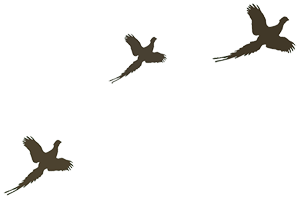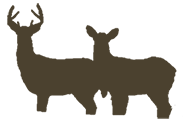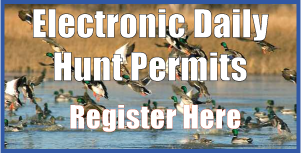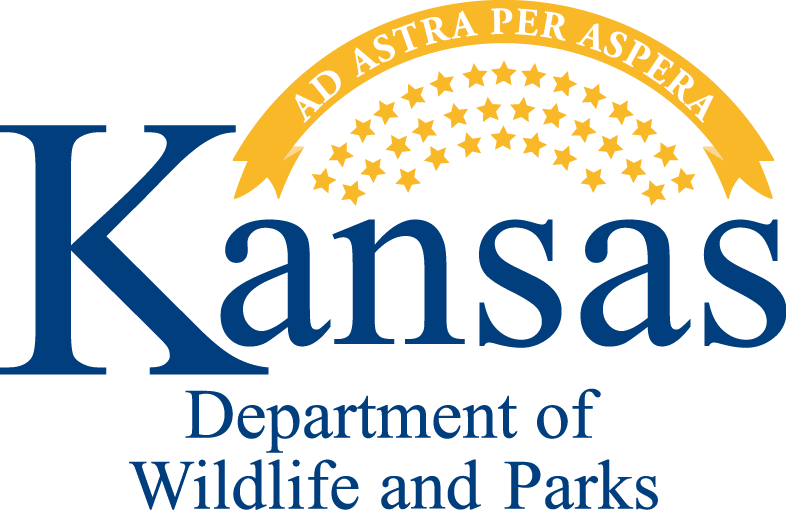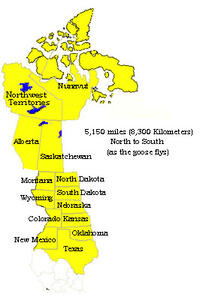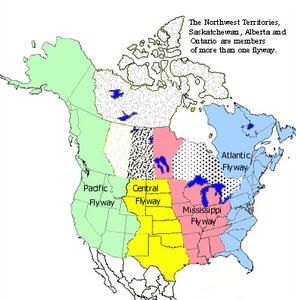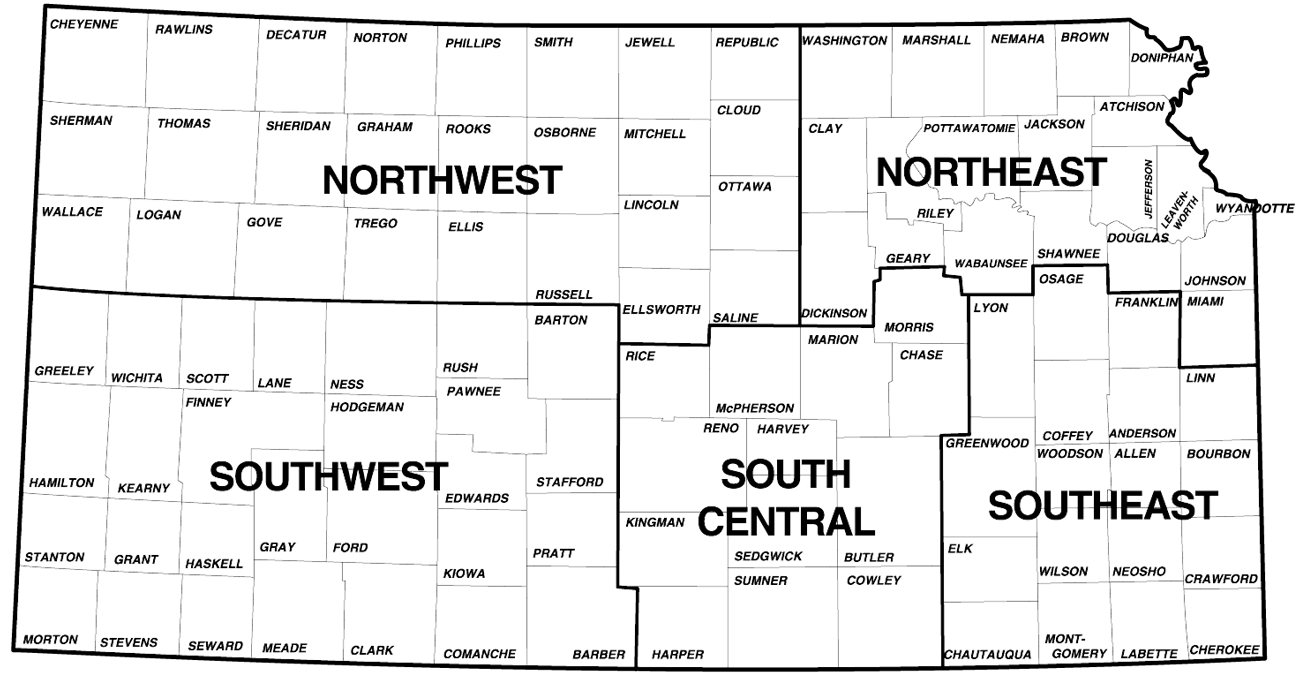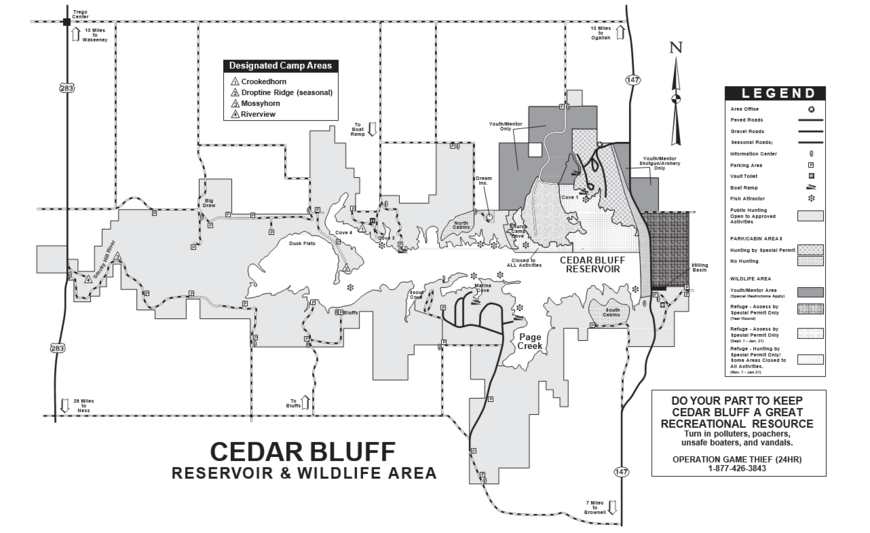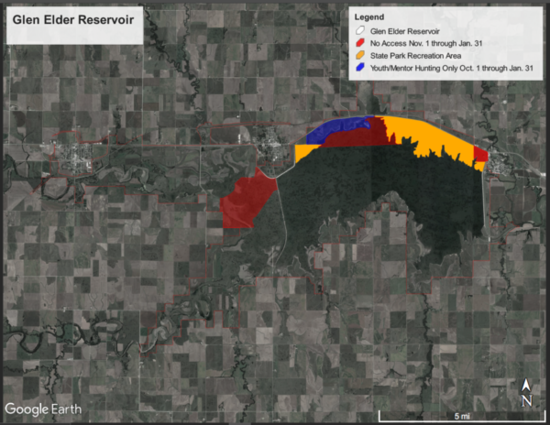Ducks

Most of the 27 species of ducks which frequent Kansas are produced in states and the Canadian provinces to the north. Although 14 species of ducks are known to have nested in Kansas, the major portion of the resident breeding population, estimated at about 20,000 pairs, is composed of wood ducks, blue-winged teal and mallards.
From 1984 through 2003 the total number of ducks reported during the 14 surveys conducted annually (two per month, September through March) on major waterfowl areas in Kansas varied from a high of 3,959,000 in 1998 to a low of 1,194,000 in 1991, and averaged approximately 2,081,000 annually. Generally speaking, duck numbers and harvest declined from levels experienced during the 1970’s, when an all time high of 10,015,000 ducks were reported during waterfowl surveys in 1972, and the average number observed each year (1970-79) was 5,820,000. This decline in Kansas duck numbers is largely due to loss of breeding habitat in Canada and states north of Kansas, aging of our reservoirs, and changing agricultural practices in our state.
The five most common ducks observed during the 14 annual surveys in Kansas include the mallard, northern pintail, green-winged teal, gadwall and blue-winged teal. Kansas is about half way down the Central Flyway’s eastern tier of states, an area crossed by some of the major migration routes of ducks. Of the five most common ducks, blue-winged teal are the first to arrive, peaking in September and early October. The next major influx of migrants occurs in late October and early November. Northern pintail begin a major buildup in late October, with green-winged teal and gadwall arriving and peaking during the first half of November. Mallards are the last of the top five to arrive, peaking in late December. The mallard is king in our state, with numbers observed commonly reaching 300,000 during the second half of December.
Although the migration chronology of Kansas ducks varies considerably from year to year, depending on weather, there is usually a gradual increase in duck numbers beginning in late August and peaking during December or early January. While data summarized on a statewide basis may show a gradual buildup of ducks, the numbers observed on a particular wetland may have migration characteristics quite different from the “state average”. A common misconception is that there is a gradual movement of ducks, north to south, during the fall and early winter periods. However, a shallow marsh near the Oklahoma border may have peak numbers in late October while a reservoir near the Nebraska border may not see maximum numbers until late December. Within Kansas, the type of habitat has a greater influence on the timing and species composition of the duck migration than does the location.
Over the long term, the fall and winter populations of ducks in Kansas should roughly correlate with the breeding population index for these species. However, numbers observed are influenced by habitat conditions in our state. Even in years of high flyway populations, poor habitat conditions in Kansas will lower fall populations and harvest in Kansas. Conversely, in years of low flyway populations, good habitat conditions in Kansas will raise Kansas fall populations and harvest.
During the past six years (1999-2004), Kansas duck hunters averaged approximately 119,000 duck hunting days, and harvested about 228,000 ducks annually. The highest Kansas duck harvest reported occurred in 1971, when an estimated 430,000 ducks were taken. In recent years, mallards have comprised about 50 percent of the total harvest, followed by gadwall at about 14 percent, and green-winged teal at 12 percent.
The future of ducks, unlike geese, is troubling. The long term degradation and loss of wetlands and native prairie on their breeding grounds is a serious problem that is difficult to address. The combination of the agricultural Conservation Reserve Program and record breaking rainfall allowed breeding numbers to rebound during the 1990’s to levels similar to those observed during 1970’s. However, discontinuance of the Conservation Reserve Program, or a return to normal rainfall levels on the breeding grounds, will have severe negative impacts on duck production and fall flights. Federal and state agencies, along with a number of private organizations are working to maintain quality breeding habitat, but the task is difficult and far from being accomplished.
CURRENT WATERFOWL NUMBERS ON WILDLIFE AREAS
For weekly updates on waterfowl numbers on Wildlife Areas during the fall and winter period go to the regional waterfowl reports.
REGULATIONS
Waterfowl Hunting regulations are set annually. Click here to view the latest Kansas Hunting & Furharvesting Regulations Summary.
Youth Waterfowl Seasons: In each of the duck zones, two days are set aside for youth waterfowl hunting (ducks and dark geese). Hunters 15 and younger may hunt under the supervision of an adult 18 or older. The adult may NOT hunt.
Youth Season Daily Bag Limit: 6 6 ducks, with species and sex restrictions as follows: 5 mallards (no more than 2 of which may be females), 3 wood ducks, 2 redheads, 2 canvasbacks, 1 pintail, and 1 scaup. The daily bag may comprise six of any other duck, such as six teal, six gadwall, or six wigeon.
Youth Season Possession Limit: Three times the daily bag limit.
Legal Methods of Taking Waterfowl
Bow and arrow, falconry, or shotgun no larger than 10-guage. Shotguns shall not be able to hold more than three shells.
Illegal Methods of Taking Waterfowl
No person shall take migratory game birds:
1) With a shotgun capable of holding more than three (3) shells, in the magazine and chamber combined.
2) With a trap, snare, fishhook, net, rifle, pistol, shotgun slug, shotgun larger than 10 gauge, poison, drug, or explosive.
3) With the use or aid of electronically amplified or recorded bird calls, or imitations of bird calls or sounds.
4) From a sink box (a low floating device, having a depression affording the hunter means of concealment beneath the surface of the water).
5) From or by means of any motor boat or sail boat unless the motor has been completely shut off and/or the sail furled, and its progress from there has ceased.
6) By the use or aid of live decoys. All tame, captive ducks and geese must be removed 10 days before hunting.
7) By driving, rallying, or chasing birds with any motorized conveyance or any sail boat to put them in range of the hunters.
Wanton Waste
By regulation, hunters must attempt to find any game crippled or killed. Retrieved animals must be kept until: 1) cleaned, 2) eaten, 3) taken home, 4) taken to a taxidermist or processor, or 5) given to another person.
Possession of Live Birds
Wounded waterfowl reduced to possession shall be immediately killed and included in the daily bag.
Transporting Harvested Waterfowl
One fully-feathered wing and /or head must remain attached to waterfowl when transported.
Shipment
No person shall ship migratory game birds unless the package is marked on the outside with: 1) the name and address of the person sending the birds, 2) the name and address of the person to whom the birds are being sent, and 3) the number of birds, by species, contained in the package.
Giving or Receiving Waterfowl
No person may receive, possess, or give to another, any freshly killed migratory game birds as a gift, except at the personal abodes of the donor or donee, unless such birds have a tag attached, signed by the hunter who took the birds, stating the hunter’s address, the total number and species of birds, and the date such birds were taken.
Tagging Requirements
No person shall put or leave any migratory game birds at any place (other than at his personal abode), or in the custody of another person for picking, cleaning, processing, shipping, transportation, or storage (including temporary storage), or for the purpose of having taxidermy services performed, unless such birds have a tag attached, signed by the hunter, stating his address, the total number and species of birds, and the date such birds were killed. Migratory game birds being transported in any vehicle as the personal baggage of the possessor are not considered as being in storage or temporary storage.
Electronic or Mechanically Operated Decoys
The use of electronic or mechanically operated decoys that do not produce bird sounds is legal.
Waterfowl Baiting Regulations
Baiting regulations differ between doves and waterfowl, and are among the most troublesome for hunters to understand. For detailed information on waterfowl baiting go to http://www.le.fws.gov/HuntFish/waterfowl_baiting.htm
Some general baiting rules that waterfowl hunters should remember:
- They may not place, expose, deposit, distribute or scatter salt, grain or other feed that could lure waterfowl to, on or over the area where they are hunting.
- They may not hunt a baited area until 10 days after all bait or feed has been completely removed.
- Hunters are responsible for ensuring that the area they plan on hunting has not been baited before they start hunting.
- Hunters may hunt all migratory game birds over natural vegetation that has been mowed or manipulated in other ways, or where seeds or grains have been scattered solely as a result of a normal agricultural planting or normal soil stabilization practice.
- Hunters may use natural vegetation to conceal or construct a blind.
- Hunters may hunt waterfowl over standing crops, standing flooded crops and flooded harvested cropland.
DUCK IDENTIFICATION
Duck regulations include species and sex specific restrictions. The ability of hunters to identify and select desired targets before shooting is important in managing the harvest and allowing maximum hunting opportunity without jeopardizing the future of our waterfowl resource. For help with duck identification go to -- http://www.npwrc.usgs.gov/resource/tools/waterfwl/waterfwl.htm
POPULATION AND HARVEST DATA
A number of population and harvest surveys are conducted annually that are utilized in the development of waterfowl management programs and regulations. To view data for Kansas and the Central Flyway, go to http://www.flyways.us/
REPORTING BANDS
Information obtained from band recoveries reported by hunters and other individuals is, along with harvest and population data, critical to the management of our waterfowl resources. Information derived from banding includes the distribution of the harvest from a particular banding area, the timing of the harvest and most importantly, the harvest rate. This information is utilized annually in the development of harvest frameworks and final regulations. To report a band call 1/800/327/2263 or go to http://www.pwrc.usgs.gov/bbl/homepage/call800.htm
THE FLYWAY PROCESS OF DEVELOPING REGULATIONS
Since most ducks are migratory birds crossing state and national boundaries, regulations and management practices that affect their population numbers must extend beyond our state and include other agencies. Establishing waterfowl regulations is an annual process that can be roughly divided into two areas. The first involves the activities of the states and provinces, working through their respective Flyway Councils in conjunction with the U.S. Fish and Wildlife Service, to develop season frameworks. “Frameworks” set the limit on maximum season length and bag limit, shooting hours, and the earliest opening and latest closing dates of the season for a particular species. This process of developing frameworks begins in December and doesn’t end until August.
Once the frameworks are established by the U.S. Fish and Wildlife Service, which has the ultimate authority for the welfare of our migratory bird resources, the states begin the second part of the annual regulatory process. This second phase involves developing and adopting season dates, bag limits and shooting hours specific to their jurisdiction. A state can always be more restrictive than allowed by the frameworks, but it cannot be more liberal. The primary consideration when developing frameworks is the long-term welfare of the species or resource. Although this consideration is still present when states develop their specific hunting regulations, greater emphasis is placed on providing the greatest amount of hunter opportunity and satisfaction within the limits of the frameworks.
The basis for a rangewide approach to duck management was provided by Fredrick Lincoln, who initiated the first large-scale banding in the United States in 1922. As Lincoln received bands from his ducks, he became convinced that waterfowl management would have to be tailored to the different migration routes. In 1935, he suggested that four flyways be established across the United States and that management regulations be tuned to the situations that prevailed in those flyways. Adoption of his proposal was slow, and it was not until 1948 that the Flyway system was implemented.
Kansas is located within the Central Flyway, which is composed of ten states including Montana and North Dakota to the north, extending south through Texas and New Mexico. Only that area of the West Tier states east of the Continental Divide is currently included within the Central Flyway boundaries. Although the basic responsibility for the management of waterfowl rests with the Federal Government, the states must be involved. In order to transcend state borders, the ten Central Flyway states have joined administratively and formed the Central Flyway Council. The directors of the state fish and game agencies of the flyway states, or their designated representatives, constitute the official voting members of the Council. Delegates from the Canadian provinces participate in Council activities, but do not vote on regulatory recommendations. The Council provides an excellent forum for communication and understanding the problems throughout the flyway and attacking these problems in a cooperative, scientific way. Much of the information needed for the management of ducks is continuously being obtained through banding, survey, and research efforts, planned and conducted by the Flyway Council and the U.S. Fish and Wildlife Service.
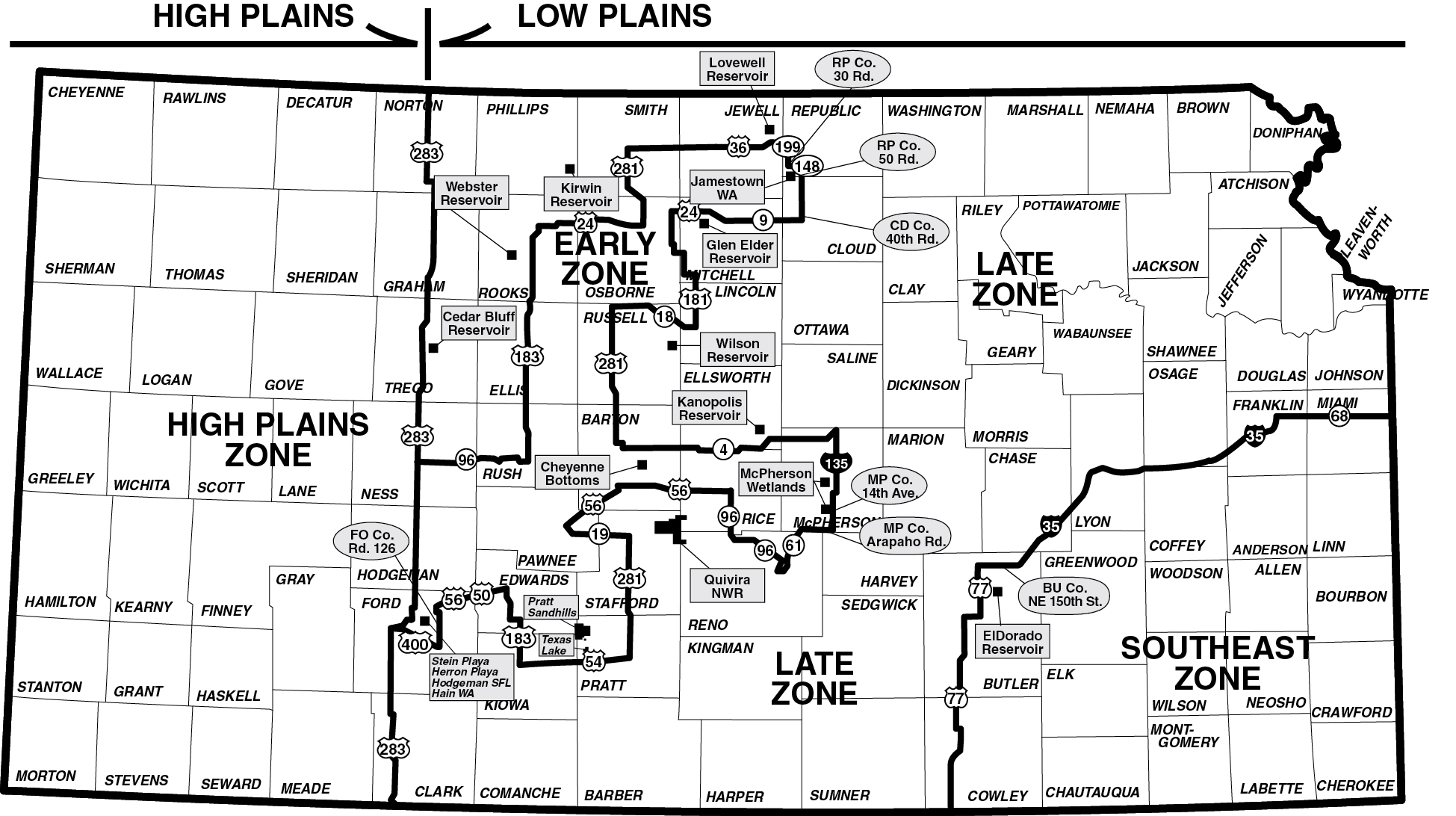
To purchase your HIP Stamp online, CLICK HERE.
Migratory Game Bird Hunters – Why is it important to be “HIP”?
If you hunt doves, ducks, geese, sandhill cranes, coots, snipe, rail, or woodcock, you are required to participate in Harvest Information Program (HIP).
What is HIP?
Harvest Information Program (HIP) is a method by which state wildlife agencies and the U.S. Fish and Wildlife Service (USFWS) use to provide reliable estimates of the number of migratory game bird hunters, hunter activity and migratory game bird harvest. These estimates provide information needed to make sound decisions concerning hunting seasons, bag limits, and population management. HIP has been a federal requirement of those hunting migratory game birds since 1998.
Who needs to be HIP?
HIP, incorrectly, has become associated more closely with waterfowl hunters. HIP applies to all those who hunt any species of migratory game birds. This would include not only ducks and geese but also doves, woodcock, rails, snipe, sandhill cranes, moorhens, band-tailed pigeons, swans, brant, coots and gallinules, for which there is a set hunting season. If you are required to buy a Kansas hunting license and plan to hunt any migratory game birds in Kansas, you are required to acquire a Kansas Harvest Information Program (HIP) permit. Even if you hold a lifetime license, you still are required to acquire a HIP permit. Exemptions from HIP include those not required to have a Kansas hunting license such as people hunting their own land and residents 15 and younger and 75 and older. It is the hunter responsibility to fulfill their HIP requirement. Proof of HIP must be carried with the hunter in the field, and, like a hunting or fishing license, must be presented to a wildlife officer upon their request. Hunting migratory birds without HIP certification is like hunting without a license—you could be ticketed or fined. You must be HIP certified for each state for which you hunt migratory game birds. The HIP certification process varies from state to state. Please confer with your local wildlife agency regarding HIP in their state.
How does HIP work?
When you purchase your Kansas HIP permit, you first are identifying yourself as migratory game bird hunter. Secondly, the licensing vendor will ask you a series of short questions relating to your hunting experience during last year's season. These questions place you in a sampling stratum from which the USFWS selects small sample to complete a more detailed survey about this year’s upcoming hunting season. These short questions that you are asked about last year’s hunting experience when you become HIP-certified are not part of the survey, and are not used to compile harvest estimates, but are simply used to identify what types of birds you usually hunt. This allows the USFWS to target its surveys to the appropriate hunters. For example, most surveys about dove harvest are sent to hunters who usually hunt doves, while most waterfowl harvest surveys are sent to hunters who usually hunt ducks and/or geese. If you only hunt ducks and geese – no snipe or rails, no moorhens or gallinules – why is it that I have to answer questions about those species? The USFWS needs to be able to contact people who hunt various birds. This narrows the field and allows the USFWS to ask more detailed questions about what was harvested.
If your name is one of the few selected for the national harvest survey, you will receive a personal letter and a hunting record form and will be asked to voluntarily keep a record of the number of migratory birds you harvest during the season. You will be given an addressed, postage-paid envelope to return your hunting form at the end of the season. This survey provides the information used to develop nationwide harvest estimates for all migratory birds. A few select participants are asked to send in wings of migratory game birds they harvest to help determine species, age, sex, and other important harvest data. All HIP responses are kept strictly confidential and are not used for any other purpose. As soon as the survey is completed, the USFWS destroys all hunter names and address records.
As HIP information is gathered at the time a hunting license is purchased whether at a store or online. At the license counter, the license agent should ask the HIP questions as part of the licensing process; if they do not inquire, you should remind them of HIP’s requirement. Kansas charges a small fee to cover administrative costs. KDWP or USFWS receives no income from this program. HIP is strictly to gather information and is not a means of raising money for conservation programs.
What do hunters gain from HIP?
An understandable question is ‘What does HIP mean to me, as an individual asked to participate in this annual series of inquiries?’ The vast majority of hunters who participate are doing so because they know it’s important and understand why it’s important as hunters. Hunters are not just people answering a survey but are partners in data collection that directly affects hunting opportunities. As the threats and concerns for migratory bird populations continue to mount, it is essential to gather the best information possible about the factors affecting these populations. It is in the hunter's best interest to have wildlife management decisions based on scientific evidence, not on opinions, philosophies, or politics. It only takes a few moments to give wildlife managers the information they need to ensure that our migratory bird resources--and hunting tradition--will be around for future generations to enjoy.
To Purchase Your Kansas HIP Permit Online: https://license.gooutdoorskansas.com
For More Information
USFWS HIP: https://www.fws.gov/birds/surveys-and-data/harvest-surveys/harvest-information-program.php
USFWS Harvest and Hunter Survey Annual Reports: https://www.fws.gov/birds/surveys-and-data/reports-and-publications/hunting-activity-and-harvest.php
Explore Harvest Data visualization for your region: https://fws.gov/harvestsurvey/harvest-vis
Central Flyway Council: https://centralflyway.org/management/harvest-surveys/
27 Species of Ducks Recorded in Kansas
| Wood duck | Aix sponsa |
| Green-Winged Teal | Anas crecca |
| American Black Duck | Anas rubripes |
| Mottled Duck | Anas fulvigula |
| Mallard | Anas platyrhynchos |
| Northern Pintail | Anas acuta |
| Blue-winged Teal | Anas discors |
| Cinnamon Teal | Anas cyanoptera |
| Northern Shoveler | Anas clypeata |
| Gadwall | Anas strepera |
| Eurasian Wigeon | Anas Penelope |
| American Wigeon | Anas Americana |
| Canvasback | Aythya valisineria |
| Redhead | Aythya Americana |
| Ring-necked Duck | Aythya collaris |
| Greater Scaup | Aythya marila |
| Lesser Scaup | Aythya affinis |
| Common Eider | Somateria mollissima |
| King Eider | Somateria spectabilis |
| Oldsquaw | Clangula hyemalis |
| Black Scoter | Melanitta nigra |
| Surf Scoter | Melanitta perspicillata |
| White-winged Scoter | Melanitta fusca |
| Common Goldeneye | Bucephala clangula |
| Barrow’s Goldeneye | Bucephala islandica |
| Bufflehead | Bucephala albeola |
| Ruddy Duck | Oxyura jamaicensis |
Use the map below to pick a region you would like to look at Waterfowl Reports.


